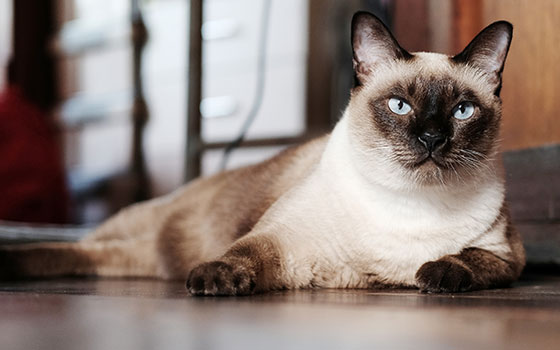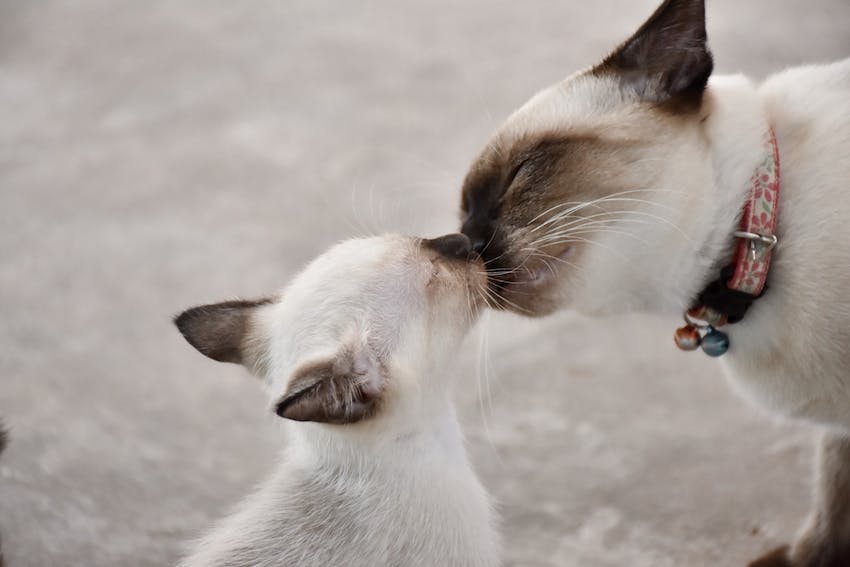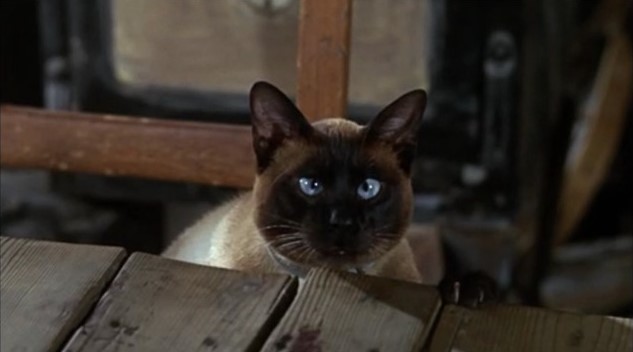Lifespan
8 to 15 years
By : Trupanion Staff | Updated Jun 13, 2024
Lifespan
8 to 15 years
Weight
6 - 14 pounds
Energy level
Ninja warrior

The point coloration is a light-color body with darker extremities. This happens because the outer extremities are at a lower temperature than the body. An enzyme involved with melanin production called tyrosinase, present in Siamese due to their partial albinism, is only activated at cooler temperatures. This is also why Siamese cats that live in cool climates tend to have darker coats than those that live in warm climates.
The Siamese coat is short and dense but doesn’t take much to maintain as long as the cat is able to clean itself regularly. Weekly brushing and regular nail trimming will keep this breed looking their best. Introduce your kitten to these experiences at a young age, keeping the experience calm and positive.
The Siamese cat is an energetic and opinionated breed that loves human companionship. Their bright blue eyes radiate intelligence and they love learning new things and exploring their environment.
While their good looks might make them appear untouchable, the Siamese cat is very playful and quite a cuddle bug. They’re known as one of the most talkative cat breeds and will chat with you all night long if you let them.
Siamese cats are highly social and enjoy the company of other cats and people. These cats become quite attached to their humans and follow them around like shadows. It’s best not to leave them alone for long periods of time, as they can become depressed or destructive with a lack of social interaction. In fact, many people adopt two Siamese cats at a time so that they can keep each other company.
Because this breed is highly intelligent and always on the hunt for entertainment, they’re often labeled as “mischievous.” Make sure you give your Siamese cat something to do, or they’ll find something on their own to occupy their time!
These cats require daily play sessions and interactions with their humans to stay happy and healthy, both physically and emotionally. This means they’re not necessarily the most independent cats. Luckily, they are good playmates with both children and other pets, especially when introduced to them as kittens.
The Siamese cat is a descendant of the Wichien Maat, or Thai breed of cat, and is considered one of the oldest naturally developed cat breeds. They’re even mentioned in Thai manuscripts dating back to 1350 AD.
In some accounts, they lived as temple cats, and in the poems found in Tamra Maew (the Cat-Book Poems) they acted as guard cats for royal jewelry. Favorites of royalty, they became known as “the Royal Cat of Siam.”
Siamese didn’t make their way to the West until 1878 when U.S. President Hayes was sent a Siamese cat named “Siam” from the American Consul in Bangkok. While the breed was shown in London at the Crystal Palace Cat Show in 1871, they didn’t start to become popular until 1884, when a Consul-General at their embassy in Siam brought back a pair of kittens for his sister. Their reception in the West was mixed at first, as their pointed color pattern and head shape were quite different than the other breeds popular at the time, such as the British Shorthair and Persian. However, as more Siamese cats were imported into Britain and the United States, a breeding program emerged, and they became a favorite.
The original Siamese cats found in Thailand had a less severe look, with a rounder body and head (referred to as an Applehead). During the 1950s and '60s, a slenderer and more angular look became popular, resulting in what’s now called the “Modern Siamese.” This modern style has a perfectly triangular and long head, tube-shaped body, long legs, and skinny tail.
While the International Cat Association (TICA) and World Cat Federation (WCF) now recognize the classic type, there is a campaign within the breeding community to separate these breeds from each other completely. One step towards doing this has already been taken, with TICA and the WCF designating any Siamese cat imported directly from Thailand as the recent Thai cat breed.
Siamese cats are high-energy breeds. But with early socialization and healthy amounts of playtime, they can become caring and affectionate pets. In fact, they're known for being one of the friendliest cat breeds.
Siamese cats are very playful, active, and require a lot of attention from their guardians. They get along moderately well with other pets and children who are old enough (i.e., 8 years of age or older) to be taught how to properly handle cats and kittens, pay attention to their body language, and not play too rough with their feline friends.

As mentioned, the Siamese is a high-energy breed that requires exercise to stay happy, healthy, and help prevent unwanted behavior. Luckily, they love to play with toys and are quite the climbers. Give them an outlet for their energy by providing them with plenty of high places to perch and jump and having lots of play sessions together.
Siamese are highly active, social, and intelligent; this combination requires that these cats are given daily enrichment activities to keep their minds and bodies active and healthy.
This breed is highly trainable because of their intelligence and desire to interact with humans. Meezers, a common nickname for this breed, like to explore and climb high places. Activities that train new behaviors, encourage exploration of various objects, and allow for problem-solving (e.g., puzzles) will be appreciated by this breed.
While not a behavior issue per se, this breed is quite chatty and vocal. Most people who have Siamese companions know and enjoy this about the breed, but if you prefer a quiet cat, this is likely not the best breed for you. Siamese cats enjoy a good conversation, particularly when their humans are present.
In order to keep their minds and bodies busy, here are a few activities Meezers might enjoy:
Siamese cats were especially popular during the golden age of Hollywood and are still today often associated with glitz and glamor. Here are just some examples of famous people who have had a Siamese cat:

Syn, the cat who starred in That Darn Cat! and played Tao in The Incredible Journey won a PATSY Award, which is like the Oscar for animals, in 1966.
Like all cat breeds, there are certain health conditions Siamese cats are prone to due to their genetics. Here's a list of some of the most prevalent health disorders and illnesses veterinarians see among the breed:
If you have a Siamese cat, it's important to remember that these are just examples, and there may be other conditions your pet is at higher risk for. That said, there's no guarantee that your cat will or won't get sick. Talk with your veterinarian about your cat's specific risks and current health status. And since you can't predict the future, protect your pet with cat insurance if you haven't already done so.